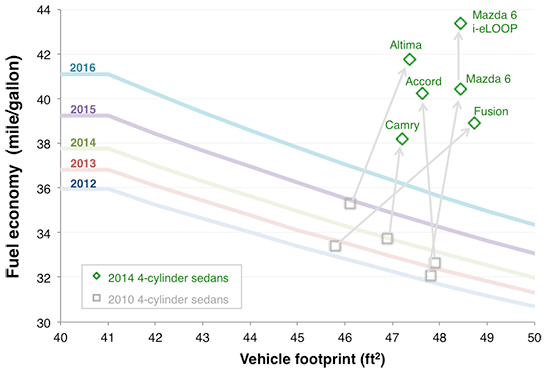Blog
Live from New York, it’s vehicle efficiency!
Beneath all the polish, glitz, and raw horsepower of the New York International Auto Show is a lot of very cool technology. In case you missed it, the first new Alfa Romeo to be offered in the U.S. in a long time is coming, there is now a 887-horsepower plug-in hybrid electric Porsche, and Ford put a Mustang on the top of the Empire State building—again. The all-electric, plug-in hybrids, and fuel cell vehicles were all pretty impressive too, and these advanced technologies just seem to keep multiplying.
But the incremental powertrain efficiency technology improvements on all the rest of the new models tend not to grab headlines. Nonetheless, all the relentless day-to-day improvements in new vehicles’ efficiency are still mighty impressive (and more likely to bring practical, affordable technologies for everyone). As I wandered around the Show, really it was the unobtrusive stuff that I kept noticing. I’m talking about the year-in, year-out engineering improvements like reducing engine friction, improved aerodynamics, lower rolling resistance tires, and improved transmissions. And the engines keep getting smaller, more powerful, and more efficient at the same time.
An example: The Mazda6’s mile-per-gallon (mpg) ratings really stuck out. On the regulatory Corporate Average Fuel Economy (CAFE) city/highway test procedure, the 4-cylinder version of the new mid-sized sedan increased from 32 mpg to 40 mpg. The Mazda6’s innovative “i-eLoop” version delivers a 43 mpg rating – or a 34% increase from the previous version. How does the new Mazda compare to its competitors? Nearly every automaker has rolled out new-and-improved high-efficiency mid-sized sedans with similarly high fuel economy: Toyota Camry (38 mpg), Ford Fusion (39 mpg), Honda Accord (41 mpg), and Nissan Altima (42 mpg).
I wanted to see what role these high-volume 2014 models could play in automakers’ efforts to meet the new CAFE standards (that is, the “35.5 mpg” 2016 standards). The standards are indexed to vehicle footprint to force advanced-technology, rather than smaller, vehicles into the fleet. So I plotted these sedans’ improvement against the CAFE footprint-indexed regulatory standards for 2012–2016 to see how the companies were progressing. The chart below shows where these four-cylinder sedans fared in 2010 against the fuel-economy standards, and where they stand today with their new models. As it turns out, the new 2014 vehicles are doing very well – in fact they greatly overshot their 2016 regulatory targets.

Mid-size 2014 sedan fuel economy, compared to 2012-2016 Corporate Average Fuel Economy Standards (Source: EPA, 2014</a>; EPA, 2014)
So the new high-volume sedans are already greatly outperforming the CAFE targets, two years early. And they are all doing it in slightly different ways. Ford applies its turbocharged direct-injection EcoBoost technology. A major trick for Mazda is its SkyActiv technology with a very high-compression ratio, direct-injection engine. Nissan makes big efficiency gains with its XTRONIC continuously variable transmission (CVT) technology. Honda also uses direct injection and a CVT. And these 4-cylinder mid-sized sedans equate to roughly a million sales per year, so this is a substantial contribution toward the companies’ regulatory compliance with CAFE and greenhouse gas emission standards.
All this new efficiency technology is entering the fleet at an unprecedented rate, and not just in mid-sized sedans. If you don’t believe it, check the technology trends by EPA, and especially look at just the last few model years. Finally, I’ll mention two more developments that could be especially exciting. Toyota has long led the world in hybrid deployment by wide margin, but stay tuned for its new Toyota New Global Architecture, which may bring turbocharging, direct injection, and lightweighting of up to 20%. And especially stay tuned for the new Ford F150. A Ford rep at the NY Auto Show suggested that the new next-gen 2.7-liter EcoBoost version of the new mostly-aluminum bodied 2015 F150 is going to offer an approximate 15% fuel economy improvement. This would deliver an astounding 28 mpg regulatory rating for a full-sized F150. This could really make for some interesting efficiency wars&mdasheven among full-size pickup trucks.
